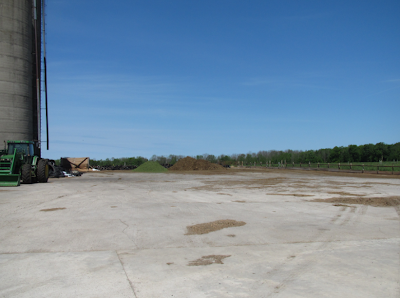The back window of our new tractor blew out today. A rock got kicked up and broke it. Kris said, "It's pretty common."
That doesn't seem like something that should be common. If the back window of my car blew out commonly, I'd be pretty annoyed. (Or not notice. There's a lot going on in my car, between the singing and group dances.)
It happened while Mike was cutting hay. That's what it's called anyway. There's a whole process for turning alfalfa into what the cows eat. Ready for the steps on making hay?
1. Planting alfalfa. It's a perennial, so you don't have to plant it every year like you do corn. You replant about every five years or when it gets scraggly.
2. Cutting. You use a discbine and cut it. It cuts it, then it gets squeezed through roller and lays it down in a row.
This is a discbine:

3. Raking. You use a rake, which is another implement you pull behind a tractor. You turn the hay over so that the bottom dries. You also pull two rows into one row so that you can chop twice as much at once.
4. Chopping. With the chopper, you chop the alfalfa that's lying on the ground and shoot it into wagons.
5. Putting it on the pile. We dump the chopped alfalfa from the wagons onto the cement pad and drive a tractor over the pile many times to compress it.
You harvest the alfalfa (do this whole process) three or four times a summer. The entire thing is very stressful and weather-dependent. Once it's cut, you don't want it to rain. If it rains, you have to wait until it dries. You don't want it to rain on the pile before you get done chopping it all ... etc.
With all the rain we've been having, we're due for a drought. I can't help but talk about the weather, even if it's cliche. It affects everyone's schedule around here ... not to mention mood. Even the tractor windows are feeling it.
 Alfalfa field
Alfalfa field






















